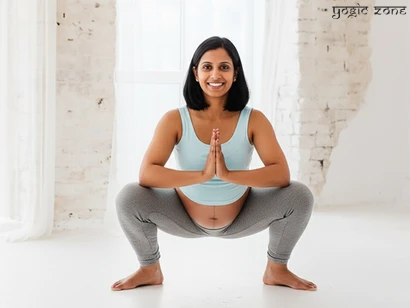
Malvi Naithani | 900-hour certified yoga instructor | 14+ years of experience | Ministry of Ayush certified prenatal & postnatal specialist. Know more about Malvi.
Pregnancy is a transformative journey for a woman, filled with joy, anticipation, and many physical changes. Prenatal yoga asanas will help you to stay active, reduce discomfort, and connect with your growing baby. This guide is meant to offer simple, supportive, and safe prenatal yoga advice to help you through your pregnancy.
What Is Prenatal Yoga?
Prenatal yoga is a modified form of traditional yoga that focuses on:
- Gentle stretching and strengthening.
- Breath awareness and relaxation.
- Safe movement suited to each trimester.
Can I Do Yoga During Pregnancy?
Yes, it is advisable to do yoga during pregnancy, and it is safe if done under the guidance of a qualified yoga trainer. Unlike regular yoga, prenatal yoga asanas avoid deep twists, intense core work, and asanas that compress the stomach or require lying flat for long periods.
Why is Prenatal Yoga Important?
Practicing yoga during pregnancy offers many benefits that go beyond physical fitness. One of the major advantages of prenatal yoga asanas is that they can contribute to a healthier pregnancy and make childbirth easier. It helps you manage common pregnancy discomforts and build a deeper awareness of your changing body.
Benefits Of Prenatal Yoga Asanas for Pregnant Women
- Reduces back pain and swelling.
- Controls blood pressure.
- Controls Gestational Diabetes.
- Strengthens pelvic floor and posture.
- Improves sleep and digestion.
- Boosts emotional well-being.
- Prepares body and mind for labor.
Trimester-Wise Asana Guide
The first trimester is a time of significant change and high risk of miscarriage. I do not recommend strenuous physical asanas until after week 12. Focus on gentle breathing exercises like Nadi Shodhana and Bhramari.
Do you have any doubts or questions about this article?? I am Malvi Naithani, the author, and I would love to hear from you. Send us your question now!
Recommended Asanas for Second Trimester
1. Marjaryasana-Bitilasana (Cat-Cow pose) is a wonderful asana for pregnancy.
The benefits of Marjaryasana-Bitilasana, or the Cat-Cow, are:
- Relieves back and neck pain. Read my article on yoga asanas for pregnancy back pain relief.
- Increases spinal flexibility.
- Gently massages the belly.
- It can help the baby move into the correct position for birth.
2. Baddha Konasana (Butterfly Pose) is a gentle and powerful seated asana, particularly beneficial for expectant mothers.
The benefits of Baddha Konasana (Butterfly Pose) are:
- Opens the hips and pelvis: Baddha Konasana stretches the inner thighs and groin muscles, which can feel tight and strained during pregnancy.
- Improves blood flow: By stimulating the pelvic area, this asana increases blood circulation to the reproductive organs.
- Supports digestion: The compression in the abdominal area created by the asana can gently massage the internal organs, which aids in digestion and can help relieve common pregnancy discomforts like constipation and bloating.
3. Virabhadrasana I & II (modified warrior poses) are a cornerstone of a prenatal yoga practice, offering both physical and mental benefits.
Benefits of Virabhadrasana are:
- Strengthens legs and builds stamina.
- Improves balance and stability.
- Opens the chest and promotes better breathing.
Note: To ensure these poses are safe and effective for pregnancy, a wider stance and use of yoga props are highly recommended.

Recommended Asanas for Third Trimester
- Malasana with a bolster or wall support is often called the “birthing squat” because it helps open the hips and pelvis.
- Side-lying Savasana (left side with cushions) is the safest relaxation pose, improves blood flow to the womb, and reduces swelling.
- Pelvic tilts (standing on all fours) are a gentle yet highly effective movement for pregnancy, providing both comfort and a proactive role in preparing for birth.
- It supports the lower back
- Encourages the baby to move into the head-down position
Note: The asanas mentioned here are recommended by our qualified and experienced authors for general awareness and inspiration. We do not provide step-by-step instructions, as each individual’s physical condition and needs are unique. We strongly recommend learning yoga under the guidance of a qualified instructor who can offer personalised support and ensure safe practice.
The Power of Pranayama
In yoga, the breath, or pranayama, is just as important as the physical asanas. Learning to control your breath can be one of the most powerful skills in your pregnancy journey. Simple breathing exercises help to calm your nervous system and increase oxygen flow to you and your baby.
The recommended pranayamas are:
- Nadi Shodhana (Alternate Nostril Breathing) balances energy and calms the mind.
- Bhramari: The gentle humming sound created during Bhramari sends soothing vibrations throughout the body.
- Deep Belly Breathing: Reduces anxiety and improves oxygen flow
Important Safety Tips
- Avoid lying flat after the first trimester
- Use props like bolsters and blocks for support
- Skip poses that feel uncomfortable or strain the stomach
- Always consult your doctor or your yoga instructor before starting any new routine
The most crucial step in your prenatal yoga asana journey is to find a certified instructor who specialises in teaching pregnant women. They will ensure you are practicing safely, with modifications suited to your specific trimester and needs. Remember, the goal of prenatal yoga is not to push your limits but to nurture your body and mind as you prepare to meet your baby.
Do you have any doubts or questions about this article?? I am Malvi Naithani, the author, and I would love to hear from you. Send us your question now!
Frequently Asked Questions About Prenatal Yoga Asanas
Is it safe to start prenatal yoga if I’ve never done yoga before?
Totally. You don’t need any yoga experience to start. Prenatal classes are made exactly for this stage—slow, supportive, and body-aware.
Which trimester is best to begin prenatal yoga, and are there differences in the routines?
Strenuous physical asanas are not recommended until after week 12. Most mothers-to-be find the second trimester (weeks 13–28) to be the most comfortable time to start because energy levels typically improve and the body has adjusted to early pregnancy changes.
Can prenatal yoga really help with labor pain and delivery preparation?
Prenatal yoga is preparation for the big day—breathing, staying calm, opening the hips, and learning to trust your body. It’s less about flexibility and more about confidence.
How often should I practice prenatal yoga for best results?
A consistent routine of 2–4 sessions per week, ranging from 20–60 minutes, is associated with improvements in posture, flexibility, stress reduction, and sleep quality. However, frequency should be adjusted based on energy levels, physical comfort, and guidance from your doctor and qualified prenatal yoga instructor.
Is it okay to do regular yoga classes while pregnant, or do I need specific prenatal sessions?
Prenatal-specific sessions are recommended because they prioritise pregnancy-safe alignment, joint protection, and breathwork tailored for labor. While individuals with prior yoga experience may modify poses in a general class, prenatal classes eliminate the need for adjustments and minimize the risk of strain or overexertion.
I’m experiencing back pain and tight hips during pregnancy—can prenatal yoga help?
Yes. Research shows that prenatal yoga can reduce lower back pain and pelvic discomfort by improving core stability, promoting neutral pelvic alignment, and increasing hip mobility. Strengthening the glutes, pelvic floor, and deep abdominal muscles helps support the spine as the center of gravity shifts.
Can prenatal yoga help with stress, anxiety, and emotional balance during pregnancy?
Prenatal yoga supports emotional well-being by activating the parasympathetic nervous system through mindful breathing and relaxation practices. Studies have shown reductions in cortisol (stress hormone) levels and improvements in mood and sleep among pregnant individuals who practice yoga regularly.
What yoga poses should I avoid during pregnancy to stay safe?
During pregnancy, it is advisable to avoid deep closed twists, forceful abdominal exercises, prolonged prone (stomach) lying, supine (back) lying after mid-pregnancy, hot yoga environments, and unsupported inversions.



